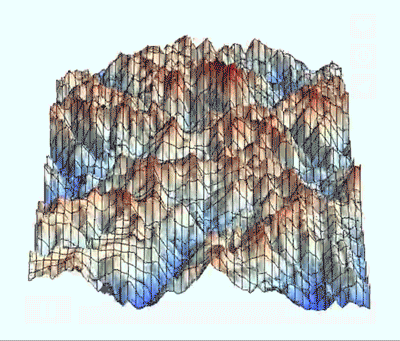
How to train your universe
Imagine you set off a Big Bang. Imagine you set off many Big Bangs. Newborn universes are all small, grubby and just a little disorganised. But you love them, and want each of them to grow into a well-balanced cosmos with an even spread of stars and galaxies, and an almost (but not quite!) smooth microwave background. What should you do?
Most cosmologists would suggest a dose of inflation, delivered at an early age. During inflation, your baby universe grows very rapidly, making sure that the grown-up universe is smooth and flat. It's like stretching out a wrinkly cloth - the more you stretch, the flatter it gets. This dramatic expansion not only smoothes away any irregular leftovers of the Big Bang, it also generates the starting ripples that eventually grow into galaxies. Places that were once almost touching now find themselves on opposite sides of the sky. The microwave background (the echo from the Big Bang we can still see today) is almost identical in every direction.

During inflation, the universe expands dramatically, diluting any leftovers of the Big Bang itself.
Cosmologists don't give tips to newbie universe-builders, but we do ask how our universe evolved. It was quickly discovered that a simple Big Bang needed very special starting conditions to grow into the universe we live in now. This is a problem for cosmology, because you then need to ask why the early universe found itself in the very special configuration that let it grow up to look the way it does today. But In 1980, physicist Alan Guth realised that a thing he called inflation made these "initial conditions problems" manageable, even if it didn't solve them completely. Inflation rapidly became part of the theorists' tool kit to make these problems easier.
What does inflation look like? In a smooth, expanding universe the distance between any two places gets bigger. But inflation makes sure that the speed at which they fly apart keeps going up. It is the empty space between galaxies that expands; "bound" objects, like atoms, solar systems, galaxies, people, kittens, etc, don't expand.
The key ingredient of inflation turns out to be negative pressure, which might sound weird, but it's not. You know what positive pressure looks like: stuff that expands, releasing energy that can be turned into motion. Like a shaken up bottle of ginger beer, or this bike pump powered water rocket:
So negative pressure may not be mysterious, but is it something that makes a universe expand? Surely you'd want positive pressure for that?
Um. Yes. Well, sort of. If the universe is pushed apart by the stuff inside it, the pressure drops as space expands. And if pressure helps universe expand, expansion slows as the universe gets bigger and the pressure gets smaller. But inflation is accelerated expansion, so paradoxically needs negative pressure. Bear with me here.
The next apparent paradox is the density of the universe during inflation. The density of a box of rocks goes down if the box gets bigger (and nothing enters or leaves the box). Double the size of the box and the density drops by a half. But wait! Stretching something with negative pressure stores energy within it, and thanks to E=em-cee-squared, this extra energy has mass. In an inflating universe, energy thins out as the universe gets bigger, but the negative pressure adds extra mass. For realistic models of inflation the density is almost constant -- the stretching of space adds energy almost as fast as the expansion dilutes it. The universe can grow a trillion, trillion, trillion times bigger during inflation but the density only falls by a factor of 1000 or so.
(You might worry that inflation somehow undercuts the conservation of energy, but when you get down to brass tacks, it's actually conservation of energy that makes it work this way.)
So what has negative pressure? In the world of particle physics, a "scalar field" is the easiest answer. It's something related to a fundamental particle (like an electron) with no spin. Right now, we have only seen one scalar particle — the Higgs, discovered at the LHC in 2012. However, not all spinless particles can cause inflation, and the Higgs does not seem to be able to do the job, so whatever is responsible for inflation has not yet been discovered.
Indeed, Guth discovered inflation by thinking about scalar fields, not the other way round.
So which scalar field made inflation happen? We don't know. Haven't a clue. The Higgs-boson (discovered in 2012) is a scalar, and so far, it's the only one we know about. But not all scalar fields lead to inflation, and the Higgs is the kind that doesn't. This is where cosmology doubles down -- we're not just looking at the beginning of the universe, we are exploring undiscovered vistas in particle physics.
In fact, inflation could have happened a trillion, trillion, trillionth of a second after the Big Bang, at energies a trillion times beyond the reach of the Large Hadron Collider. This makes it very difficult to replicate experimentally! But there's still ways we can gaze into the microwave background to find evidence of inflation. And if we do, we will know that inflation is a compelling answer to cosmology's initial-conditions problems, and humankind will have looked directly into the cosmic dawn.
No pressure. No pressure at all. Negative pressure, in fact.▼
-
Richard Easther is a physicist at the University of Auckland. Richard is @reasther on Twitter; this article is republished from his blog at excursionset.com You can send him questions on cosmology, physics, or studying science at r.easther@auckland.ac.nz
-

